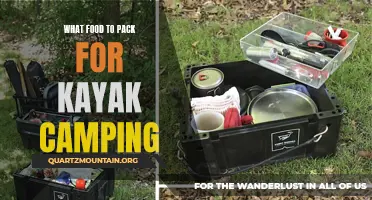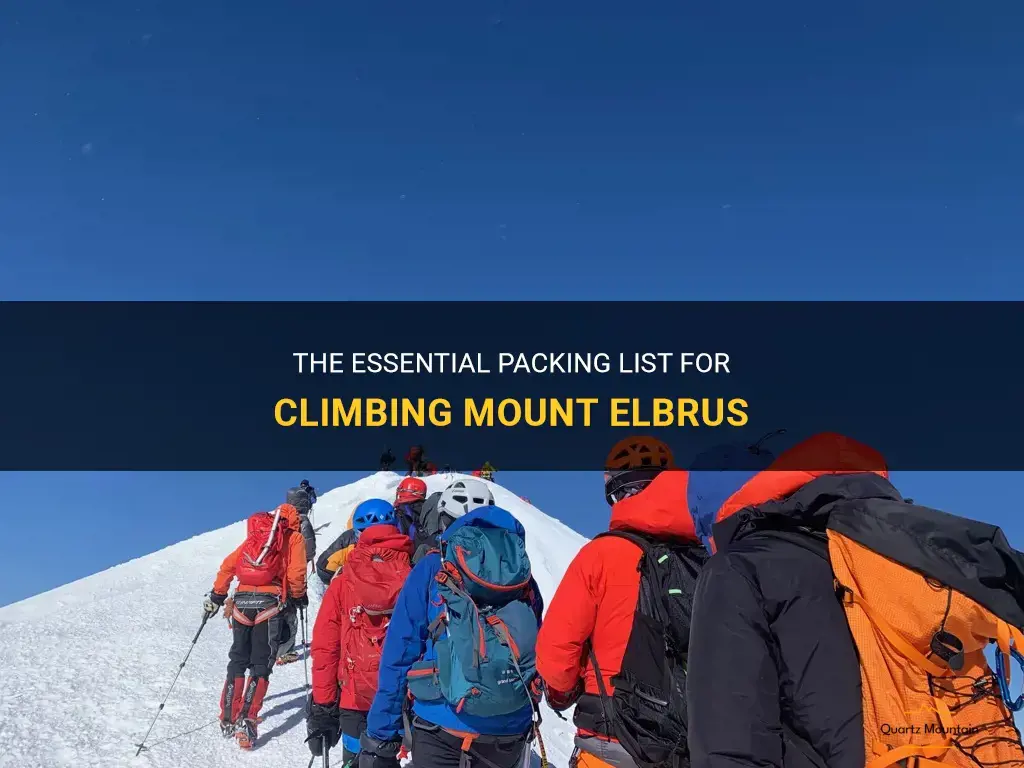
Climbing Mount Elbrus, the highest peak in Europe, is a challenge that many adventurous souls dream of conquering. However, before embarking on this incredible journey, it is crucial to have the essential packing list to ensure a safe and successful climb. From sturdy climbing gear to warm clothing for extreme weather conditions, this comprehensive guide will equip you with everything you need to tackle the majestic Mount Elbrus. So, get ready to embark on the adventure of a lifetime and reach the summit with confidence!
| Characteristic | Value |
|---|---|
| Elevation | 5,642 meters (18,510 feet) |
| Temperature | Ranges from -20°C to -30°C (-4°F to -22°F) |
| Clothing | Layered clothing, including insulated and waterproof clothing |
| Footwear | Sturdy and waterproof boots, preferably with crampon compatibility |
| Headgear | Wool or fleece hat, balaclava, and goggles |
| Gloves | Insulated and waterproof gloves |
| Backpack | Large backpack (60-80 liters) for carrying gear |
| Sleeping Bag | Warm and insulating sleeping bag suitable for cold temperatures |
| Food | High-energy, lightweight food such as energy bars and dehydrated meals |
| Water | Water bottles or hydration system capable of carrying enough water for the duration of the climb |
| Sun Protection | Sunscreen, sunglasses, and lip balm with high SPF |
| Climbing Equipment | Crampons, ice axe, helmet, harness, and ropes |
| Communication | Two-way radios or satellite communication device |
| First Aid Kit | Comprehensive first aid kit including medications for altitude sickness |
| Navigation Tools | Map, compass, and GPS device |
| Miscellaneous Items | Headlamp, trekking poles, gaiters, camera, toilet paper, and toiletries |
| Training | Physical fitness training and acclimatization before the climb |
What You'll Learn
- What essential items should be packed when planning a trip to Mount Elbrus?
- Are there any specific clothing or gear recommendations for climbing Mount Elbrus?
- How should one prepare their backpack for a successful summit attempt on Mount Elbrus?
- Are there any specific food or drink items that should be included in a Mount Elbrus packing list?
- Are there any safety equipment or emergency items that should be included in a Mount Elbrus packing list?

What essential items should be packed when planning a trip to Mount Elbrus?
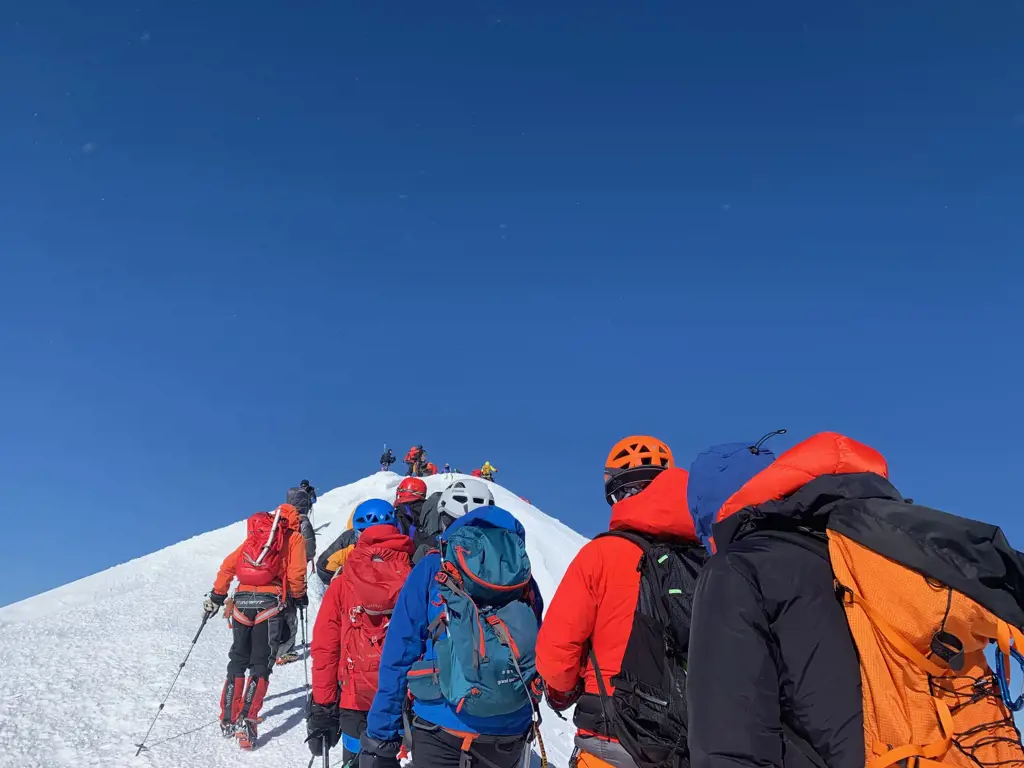
Mount Elbrus, located in the Caucasus Mountains of Russia, is one of the world's most famous and challenging mountains to climb. Standing at a height of 5,642 meters (18,510 feet), it requires careful planning and preparation to ensure a safe and successful ascent. When packing for a trip to Mount Elbrus, there are several essential items you should include to ensure your comfort and safety during the expedition.
Climbing Gear:
- Climbing Boots: Invest in a good pair of mountaineering boots that provide ankle support and have crampon compatibility.
- Crampons: These metal spikes attach to your boots and provide traction on icy slopes.
- Ice Axe: An essential tool for self-arrest and balance on steep, icy terrain.
- Harness: A climbing harness is necessary for safety during roped sections.
- Helmet: Protect your head from falling rocks and ice.
Clothing:
- Base Layers: Choose moisture-wicking materials that will keep you dry and warm.
- Insulating Layers: Fleece jackets or down jackets are crucial to provide warmth in cold conditions.
- Hardshell Jacket and Pants: These waterproof and windproof outer layers will protect you from the elements.
- Gloves: Bring both warm insulated gloves and lightweight gloves for dexterity.
- Hat and Balaclava: Keep your head and face protected from the cold.
Camping Gear:
- Tent: A sturdy, four-season tent that can withstand harsh weather conditions is essential.
- Sleeping Bag: Choose a sleeping bag rated for cold temperatures, preferably with a down or synthetic insulation.
- Sleeping Pad: A foam or inflatable sleeping pad will provide insulation and cushioning.
- Stove and Fuel: A lightweight stove and sufficient fuel for cooking meals on the mountain.
- Food and Water: Pack lightweight, high-energy, and dehydrated meals. Carry water purification tablets or a water filter to replenish your water supply.
Navigation and Communication:
- Map and Compass: Familiarize yourself with the route and take a detailed map and compass for navigation.
- GPS Device: A handheld GPS device can be helpful for tracking your progress and locating key waypoints.
- Two-Way Radio: Ensure clear communication with your climbing partners and base camp.
Safety Equipment:
- Avalanche Transceiver: In winter or when avalanche conditions are present, an avalanche transceiver is crucial for rapid location in case of burial.
- Probe and Shovel: These tools are essential for digging out avalanche victims.
- First Aid Kit: Carry a comprehensive first aid kit that includes essentials such as bandages, medication, and blister treatment.
Miscellaneous:
- Sunglasses: Protect your eyes from the intense sunlight reflected off the snow.
- Sunscreen: Apply a high SPF sunscreen to prevent sunburn at high altitudes.
- Headlamp: A lightweight headlamp with extra batteries for early morning alpine starts or night navigation.
- Backpack: Choose a backpack with enough capacity to carry all your gear comfortably.
- Extra Clothing and Socks: Pack extra layers of clothing and spare socks for wet or cold conditions.
In addition to these essential items, it is crucial to consult with experienced mountaineers or professional guides to ensure you are properly equipped for the unique challenges of Mount Elbrus. Understanding the weather patterns and conditions of the mountain is also essential for packing the appropriate gear. By preparing adequately and bringing the necessary items, you can increase your chances of a safe and successful climb of Mount Elbrus.
Hurstville Maternity: Essential Items to Pack for a Smooth Birth Experience
You may want to see also

Are there any specific clothing or gear recommendations for climbing Mount Elbrus?
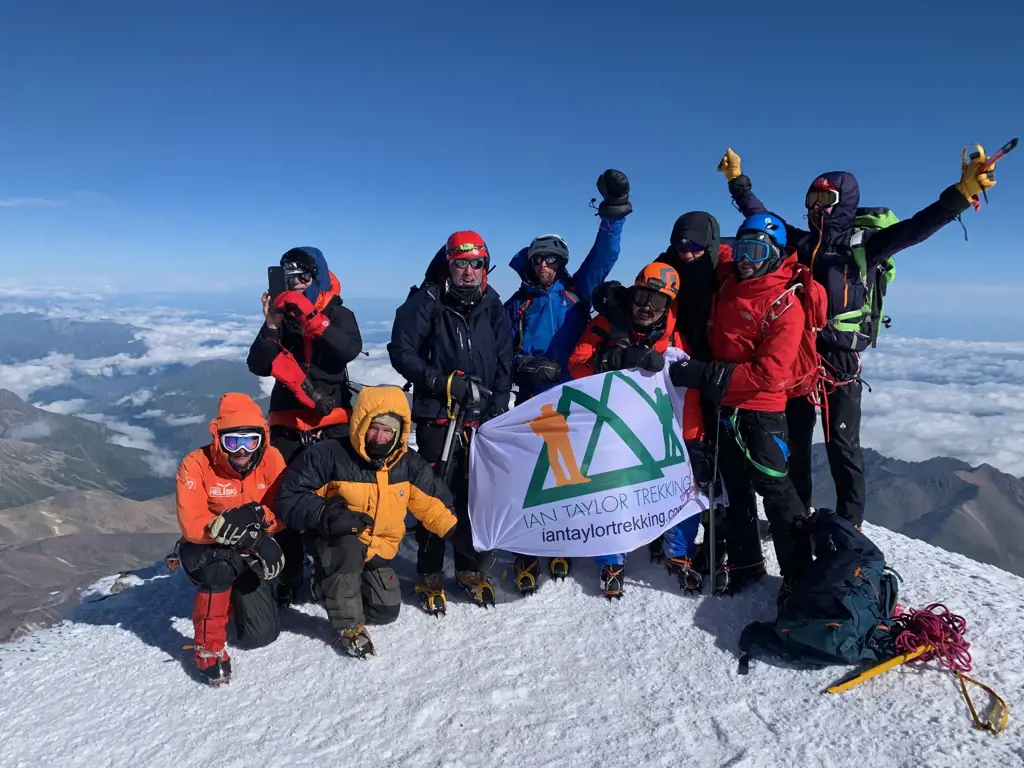
Climbing Mount Elbrus, the highest peak in Europe, is a challenging and exciting adventure. However, it is essential to come prepared with the right clothing and gear to ensure a safe and comfortable ascent. In this article, we will provide you with specific recommendations for clothing and gear when climbing Mount Elbrus.
- Layered Clothing: Mount Elbrus experiences variable weather conditions, ranging from extreme cold to warmer temperatures. It is crucial to have a layered clothing system to adapt to these changing conditions. Start with a moisture-wicking base layer, followed by an insulating mid-layer, and finally a waterproof and windproof outer layer. This system allows you to regulate your body temperature effectively.
- Insulating Jacket: An insulated, down or synthetic jacket is essential for keeping you warm during colder temperatures, particularly during the summit push. Look for jackets with high loft and good insulation properties to stay comfortable in freezing conditions.
- Breathable Pants: Choose waterproof and breathable pants that allow perspiration to escape while keeping you dry. GORE-TEX or similar materials work well to protect you from snow, wind, and rain. Ensure they have reinforced knees and seat areas for durability.
- Mountaineering Boots: Invest in good-quality mountaineering boots with stiff soles and good ankle support. These boots will provide the required traction, stability, and insulation for walking on snow and ice. Make sure they are properly broken in before your climb to avoid blisters and discomfort.
- Crampons: Crampons are essential for walking on icy and snowy terrain. The spikes on the bottom of your boots will provide grip and prevent slipping. Get crampons that are compatible with your boots and practice using them before your climb.
- Gaiters: Gaiters are protective covers that go over your boots and lower legs, keeping snow, debris, and moisture out. They enhance waterproofing and prevent your boots from getting wet, ensuring your feet stay dry and warm.
- Gloves: Invest in high-quality gloves suitable for mountaineering. It is advisable to have a thin liner glove as well as a thicker insulated glove for colder conditions. Look for gloves that offer good dexterity while also providing warmth and protection.
- Headwear: A warm hat that covers your ears is essential, as well as a neck gaiter or a balaclava to protect your face and neck from harsh winds and cold temperatures. Additionally, sunglasses with UV protection are crucial to shield your eyes from the sun's glare reflected off the snow.
- Backpack: A sturdy and comfortable backpack is necessary for carrying your gear during the climb. Look for a pack with a capacity of at least 40-50 liters and features such as a hydration system compatibility and attachment points for ice axes and other equipment.
- Other Gear: Additionally, consider bringing trekking poles for added stability, a headlamp for early morning or late-night climbs, and a sleeping bag suitable for cold temperatures, if camping is included in your itinerary.
Remember that these recommendations are general guidelines, and it is essential to consult with experienced mountaineers or guides who can provide specific advice based on your individual needs and the current conditions on Mount Elbrus. Proper clothing and gear are crucial to ensure your safety and comfort while climbing Mount Elbrus, so make sure to invest in quality equipment and practice using it before your climb.
Essential Items to Pack for a Trip to Boston in September
You may want to see also

How should one prepare their backpack for a successful summit attempt on Mount Elbrus?
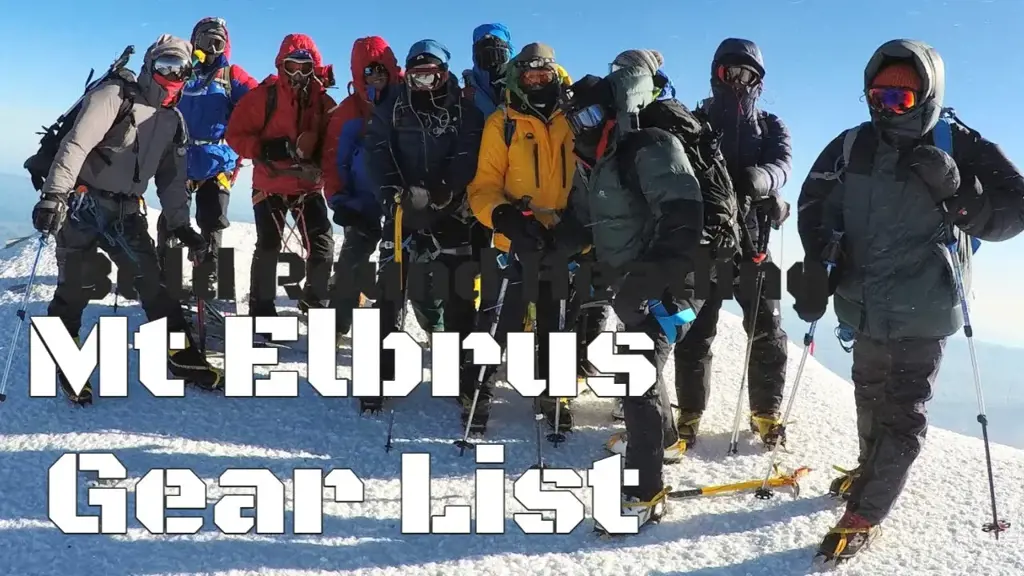
Mount Elbrus, located in the Caucasus Mountains, is one of the Seven Summits and a popular destination for mountaineers and climbers. Standing at 5,642 meters (18,510 feet), reaching the summit of Mount Elbrus is a challenging and rewarding experience. To ensure a successful summit attempt, proper preparation is essential. Preparing your backpack with the right gear is crucial for comfort, safety, and success. Here are some steps to follow when packing your backpack for a Mount Elbrus expedition:
Step 1: Create a comprehensive gear list
Before packing your backpack, it is important to create a comprehensive gear list to ensure that you have all the necessary items. The gear list should include essential items such as a tent, sleeping bag, sleeping pad, stove, cookware, and food. Additionally, you will need proper clothing and footwear suitable for extreme cold temperatures, gloves, hats, sunglasses, sunscreen, a headlamp, a map, a compass, a first aid kit, and personal hygiene items.
Step 2: Pack lightweight and compressible gear
When embarking on a Mount Elbrus expedition, it is crucial to pack lightweight and compressible gear. The weight of your backpack can greatly impact your endurance and ability to maneuver through challenging terrains. Look for gear that is specifically designed for mountaineering and is lightweight without compromising on durability. Consider investing in lightweight and compressible sleeping bags, tents, and clothing to save space in your backpack.
Step 3: Organize your gear for easy access
Proper organization of your gear is essential for quick and easy access during the expedition. Use packing cubes or stuff sacks to organize your gear into different categories, such as clothing, food, cooking equipment, and personal items. This will help you find what you need without having to dig through your entire backpack. Additionally, pack frequently used items such as snacks, gloves, and a map in easily accessible pockets or compartments.
Step 4: Test and familiarize yourself with your gear
Before embarking on your Mount Elbrus expedition, it is important to test and familiarize yourself with all your gear. Set up your tent, try on your clothing and footwear, and test your stove and cookware. This will help you identify any issues or adjustments that need to be made before you start your ascent.
Step 5: Consider the weather conditions
The weather conditions on Mount Elbrus can be extreme and unpredictable. It is important to consider the expected weather conditions and pack accordingly. Layering your clothing is crucial to adapt to changing temperatures. Make sure to pack insulated and waterproof jackets, pants, and gloves to protect yourself from cold temperatures and harsh winds.
Step 6: Keep weight balanced and distributed
When packing your backpack, it is important to distribute the weight evenly to maintain balance. Place heavy items near your spine and close to your back, while lighter items can be placed towards the bottom or on the outside pockets. This will help you maintain stability and reduce the strain on your shoulders and back.
In conclusion, preparing your backpack for a successful summit attempt on Mount Elbrus requires careful planning and organization. Creating a comprehensive gear list, packing lightweight and compressible gear, organizing your gear for easy access, testing your gear, considering the weather conditions, and keeping weight balanced and distributed are crucial steps to ensure comfort, safety, and success. With proper preparation and the right gear, you can maximize your chances of a successful summit attempt on Mount Elbrus.
Finding the Perfect Size Dildo for Packing: A Complete Guide
You may want to see also

Are there any specific food or drink items that should be included in a Mount Elbrus packing list?
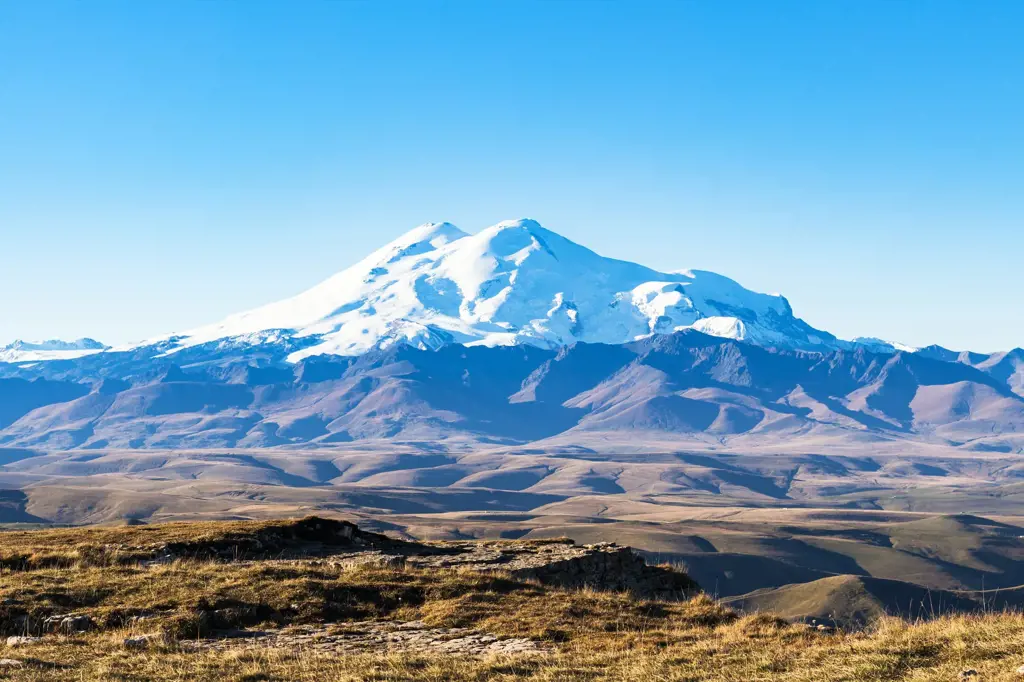
When preparing for a Mount Elbrus expedition, it is crucial to include specific food and drink items in your packing list. Proper nutrition and hydration are vital for a successful climb, as they provide the energy and endurance needed to tackle the challenging terrain and high altitude. In this article, we will discuss the essential food and drink items that should be included in your Mount Elbrus packing list.
High-Energy Foods:
Include high-energy foods in your packing list to fuel your body during the climb. These can include items like energy bars, trail mix, nuts, dried fruits, and chocolate. These foods are lightweight, compact, and provide the necessary carbohydrates, fats, and proteins needed for sustained energy.
Instant Meals:
Pack a few instant meals that require minimal preparation. These can be useful during long days on the mountain when you need a quick and easy meal. Look for meals that are high in calories and provide a balance of macronutrients. Freeze-dried meals are a popular choice as they are lightweight and can be prepared with boiling water.
Electrolyte-Replenishing Drinks:
Hydration is crucial when climbing Mount Elbrus, especially at high altitudes. Include electrolyte-replenishing drinks such as sports drinks or electrolyte tablets in your packing list. These will help replenish the essential minerals lost through sweat and ensure proper hydration.
Water Filtration System:
It is essential to have a reliable water filtration system when climbing Mount Elbrus. While there are natural water sources available, it is advisable to treat the water before consumption. Pack a water filter or purification tablets to ensure safe drinking water throughout your expedition.
Tea and Hot Drinks:
Cold weather is common on Mount Elbrus, even during summer months. Packing tea bags or other hot drink mixes can provide comfort and warmth during breaks or at camp. Additionally, herbal teas like chamomile or peppermint can help with digestion and relaxation.
High-Calorie Snacks:
Include high-calorie snacks like cheese, salami, or peanut butter in your packing list. These items provide a good balance of fats and proteins and can help keep your energy levels up during long days on the mountain.
Reusable Water Bottles or Hydration Bladders:
Pack reusable water bottles or hydration bladders to carry water during your climb. These options are more sustainable than disposable water bottles and can easily be refilled at water sources along the route.
When packing your food and drink items for Mount Elbrus, consider the weight and portability of each item. It is essential to strike a balance between carrying enough food and drink for your journey while keeping your pack weight manageable.
In conclusion, including specific food and drink items in your Mount Elbrus packing list is crucial for a successful climb. Focus on high-energy foods, instant meals, electrolyte-replenishing drinks, and teas or hot drinks. Also, remember to pack a water filtration system, high-calorie snacks, and reusable water bottles. By properly fueling and hydrating your body, you will be better prepared for the physical demands of climbing Mount Elbrus.
Essential Items to Pack for Your Trip to Caye Caulker
You may want to see also

Are there any safety equipment or emergency items that should be included in a Mount Elbrus packing list?
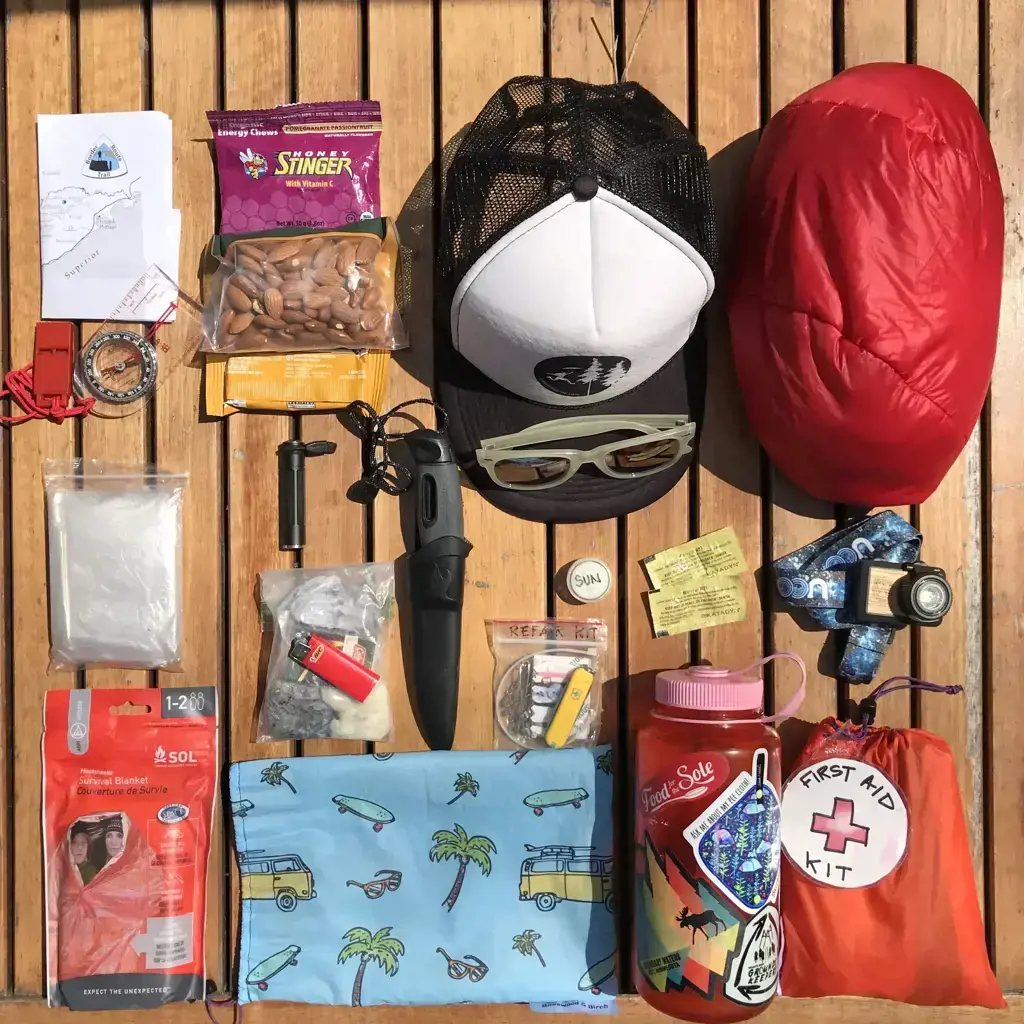
Mount Elbrus is the highest mountain in Europe, standing at 5,642 meters (18,510 feet) tall. As such, climbing this mountain is a challenging endeavor that requires proper planning and preparation. One crucial aspect of this preparation is ensuring that you have the necessary safety equipment and emergency items with you. In this article, we will discuss some of the essential items that should be included in a Mount Elbrus packing list for safety and emergencies.
- Climbing Helmet: A climbing helmet is a must-have item when ascending Mount Elbrus. It provides protection against falling rocks and ice, which can be common hazards on the mountain. A well-fitted and durable helmet can greatly reduce the risk of head injuries in case of an accident.
- Crampons: Crampons are specialized spikes that are attached to your boots to improve traction on ice and snow. Mount Elbrus has steep slopes and icy terrain, so crampons are necessary to maintain stability and prevent slips and falls. It is important to choose crampons that are compatible with your boots and practice using them before the climb.
- Ice Axe: An ice axe is an essential tool for mountaineering, particularly on glaciated terrain. It can be used for self-arrest if you slip and begin sliding down a slope. Additionally, an ice axe can also help you in cutting steps and creating anchors for protection. Make sure to choose an ice axe that is the appropriate length for your height and practice its proper use before the climb.
- Avalanche Safety Equipment: Mount Elbrus is known for its avalanches, especially during the winter season. Carrying avalanche safety equipment such as a transceiver, probe, and shovel is crucial for your safety. A transceiver is used to locate buried climbers in case of an avalanche, while a probe and shovel are used for digging them out. It is essential to receive proper training on how to use these items and practice with them before the climb.
- First Aid Kit: A well-stocked first aid kit is a must-have item for any climbing expedition, and Mount Elbrus is no exception. The kit should include essentials such as bandages, adhesive tape, antiseptic wipes, pain relievers, and blister treatment. It is essential to familiarize yourself with the contents of the kit and know how to use them effectively in case of injuries or emergencies.
- Emergency Shelter: In case of unexpected weather changes or emergencies, having an emergency shelter such as a bivvy bag or a lightweight tent is crucial. These shelters provide protection from the elements and can be a lifesaver in extreme conditions. It is important to choose a shelter that is lightweight, easy to set up, and can withstand harsh weather conditions.
- Communication Devices: Carrying communication devices such as a satellite phone, two-way radios, or a personal locator beacon (PLB) is essential for staying connected and calling for help in case of emergencies. However, it is important to note that the effectiveness of these devices may vary depending on the altitude and the surrounding terrain. It is recommended to have multiple means of communication and backup options.
- Extra Food and Water: It is essential to carry extra food and water to provide sustenance in case of unexpected delays or emergencies. The physical exertion and high altitude can lead to increased calorie and fluid requirements. It is advisable to carry lightweight, high-energy food items such as energy bars, nuts, and dried fruits. Additionally, having a reliable water purification system or water filtration tablets is essential to ensure a safe and clean water supply.
In conclusion, when preparing for a climb on Mount Elbrus, it is crucial to include safety equipment and emergency items in your packing list. These items, such as climbing helmets, crampons, ice axes, avalanche safety equipment, first aid kits, emergency shelters, communication devices, and extra food and water, are essential for your safety and well-being. It is important to familiarize yourself with the proper use of these items and seek proper training before embarking on the climb. Remember, being prepared and having the right equipment can make all the difference in ensuring a safe and successful climb on Mount Elbrus.
How to Pack for the Day with Day Designer: Essential Items to Include
You may want to see also
Frequently asked questions
When packing for Mount Elbrus, it is essential to prioritize warm and waterproof clothing. Layering is key for regulating body temperature, so pack thermal base layers, fleece or down jackets, waterproof outer shells, and insulated pants. Don't forget to bring warm socks, gloves, a hat, and a buff or scarf to protect your face from freezing temperatures and wind chill.
Choosing the right boots for Mount Elbrus is crucial. Opt for double boots with a strong insulation layer to protect against extreme cold. These boots provide better warmth and stability, as they consist of an inner insulated boot and a sturdy outer shell. Additionally, make sure your boots are well broken in before attempting the climb to avoid blisters.
Yes, there are several gear requirements for climbing Mount Elbrus. You will need crampons, an ice axe, a helmet, and a harness for glacier travel. Gaiters are also essential to keep snow out of your boots. It is highly recommended to bring trekking poles for added stability during the ascent and descent.
In addition to clothing and gear, there are a few other essential items to bring. These include a good quality sleeping bag suitable for cold temperatures, a headlamp with spare batteries, sunscreen with a high SPF, sunglasses with UV protection, and a well-stocked first aid kit. It's important to bring plenty of high-energy snacks and water bottles to stay hydrated throughout the climb.
It is vital to pack light and only bring the essentials. Remember, you will need to carry all your gear during the climb, so minimizing weight is crucial. It's also recommended to pack a few extra pairs of warm socks and gloves in case they get wet or damaged. Lastly, don't forget any necessary personal medication and make sure to check with your tour operator or guide for any specific recommendations or requirements for your ascent.



